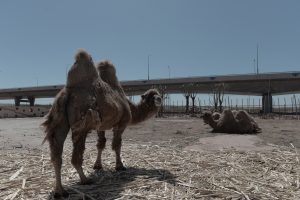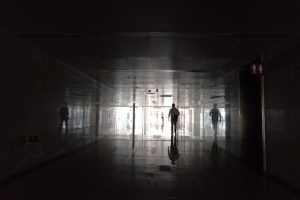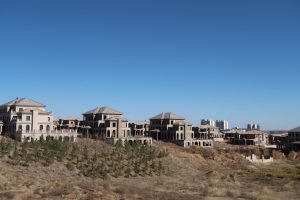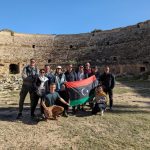Yang, our driver, is inching the car forward. We’re filming from the back seat. It’s late in the evening and in this part of town there are no streetlights, it’s almost pitch black. We follow the silhouette of a man stumbling along the pavement, torch on his forehead and a ghost detector in his hands. He reaches the end of a line of buildings and starts to retrace his steps, and Yang reverses the car keeping speed alongside him. We’re on the north side of the city of Ordos, where the skyscrapers meet the desert scrub, with a coal plant lit up on one side of the road and dark, empty buildings on the other side.
I’ve been guiding tours with Young Pioneer Tours in Ordos for a few years now, after meeting Gareth Johnson of YPT in 2011 in the countryside near Yan’an, where Mao and the Chinese Communist Party ended up at the end of the Long March. Hundreds of kilometres north of Yan’an and you get to Ordos, the infamous ghost city of Inner Mongolia. And every now and again we have a tour that is a little out of the ordinary.
Not in town for the sights of the region, but for the buildings and the roads, empty of people and traffic, this time I’m back in Ordos with a trio of Americans making a film. They are here working on a new project, I can’t give away the exact details but their journey has taken them from the metropolis of Shenzhen all the way to the ghost city of Ordos.
Ordos lies in the west of Inner Mongolia, where the Gobi desert hits the grasslands. Having been renamed Ordos in the 1990s, to give the place its Mongolian flavour again, in 2003 the city began constructing a new district, Kangbashi, out of the sand dunes 25 kilometres south of the main city. Built to house over a million people, it has no more than 100,000 residents, even after the government relocated urban civil servants to Kangbashi New Area. Like the National Ethnic Games held in 2015, many events are held here to try to raise its profile, with the biggest being Miss World in 2012, but restaurants still close in the afternoons and it can be difficult to find a beer of an evening.
Having grown rich on coal money they spared no cash in this project. Huge highways link the two parts of the city, and you drive past three Olympic size stadiums recently finished for the Ethnic Games, built to rival the Birds Nest in Beijing. The central part of town is built according to ideas of feng shui, the main squares link the government buildings in the auspicious north, surrounded by concrete statues of Mongolian heroes, to the six skyscrapers south of the river, standing in line like the incense sticks in a temple. A gold Buddha sits in front to the left, with a giant urn in front. As Yang noted, “the Communist Party spends all its time telling us not to be superstitious, and then they do this.”
Kangbashi is a truly amazing place, a ghost town but not in the sense of the abandoned cities of the post-Soviet world, but of a city built with piles of cash and high expectations that has never attracted the residents it assumed would come. “They will come,” Yang says, as do all the locals, but I’m not so optimistic. It is beautiful though, the centre of Kangbashi district is dominated by its architecture. The concrete oblong government buildings ubiquitous to every Chinese city face the six skyscrapers. The museum, built in the shape of a Mongolian hat, sits next to the library, built as three books standing up on a shelf. And the various ‘European’ or ‘American’ style residential complexes fill out from the centre.
It is these complexes that really provide the background to this haunted city. Some stand finished, with residents already moved in to some of the flats, while others loom as unfinished martyrs to the property capital flight out of Inner Mongolia, including a whole mansion complex outside of the city. Some, having already sold individual flats, lacked the capital to finish the job and they stand as empty shells as the few individual residents come and go over the rubble strewn around outside and up the stairwells.
 “China in general has a problem, lots of people but not much land, but here we have lots of land and not many people. They didn’t need to build 20 or 30 floor buildings, but the developers and the government thought that if we didn’t have skyscrapers here in Ordos then nobody would want to come here. They also never thought the money would run out. And not having high buildings would be an extreme loss of face for the local government.” As always, Yang’s explanations hit the nail on the head.
“China in general has a problem, lots of people but not much land, but here we have lots of land and not many people. They didn’t need to build 20 or 30 floor buildings, but the developers and the government thought that if we didn’t have skyscrapers here in Ordos then nobody would want to come here. They also never thought the money would run out. And not having high buildings would be an extreme loss of face for the local government.” As always, Yang’s explanations hit the nail on the head.
After filming at dusk in the abandoned streets and industrial dystopian skyline of the Ordos main city, we relocated south to Kangbashi new district. Unlike a normal Young Pioneers tour group, we didn’t follow the itinerary, we didn’t spend long at the sites around the centre – instead we searched out the best sets for the film. For the desert scene we headed to the massive sand dune standing just outside but overlooking the whole of Kangbashi.
“I think we need a camel.” This was one of the more unusual requests made of me on a YPT tour, but at the sand dune we were in the right place. An elderly couple kept camels at the foot of the dune, and for 100 yuan we not only hired the camel for an hour, but even got the old man in the film as an extra, unquestioningly letting us film him passing over the camel’s rope to our actor. Later as we stood and watched the filming on the dune the old man confided in me that if we wanted to see ghosts we should look on the old single track road leading out to the grasslands, who can sometimes be seen emerging from the morning mists, though Yang laughed and said this was more likely to be the drinkers who hadn’t made it back to their village the night previously.
Adjacent to the dune was the last of the residential areas, which had even made it this far out of the city. A special area, this was the last site we would attempt to film in. The buildings had been completed but the flats lay empty except for one, occupied by an old couple who have to climb up the dark stairwells to get home. They had bought the flat when the property developers had promised modern, comfortable living. But failing to sell enough flats the area was abandoned, guarded only by an old man on sentry duty. The old couple had cut their losses and moved in to the complex, even though there are no working lifts and outside it still resembled a construction site, an advert with the face of Warren Buffet standing on its side, visited only by the stray dogs the old sentry feeds.
On our way there a dead snake across the road in front of us. “Poisonous fuckers” Yang noted. “We’re making a film,” I explained to the sentry, “it’s about…” He cut me off. “I don’t care what’s its about, I’m not a cultured man” he explained, “Go in and have a look around.” Inside the residential complex he frightened away the dogs and we entered the buildings. The flats were accessible and totally empty. One of the rooms had been turned into a makeshift toilet for the workers, and one wall in a flat on the 4th floor was decorated in a chalk drawing of a face, tears dripping from the eyes. “Why did you leave me?” scrawled next to it.
We started filming at nightfall, shooting the actor from the building opposite. The four of us had split into two groups and we were on the 6th floor looking across at each other. But then we saw blue and red flashing lights, the police had come, probably alerted by the one couple living in the complex. They came inside the gate and we could see them from the window, we crouched down and waited, knowing they had no chance of finding us in the pitch black. Eventually, they left, and when we made ourselves scarce Yang said he had explained what we were doing to the police. “Don’t bother the locals” was their parting advice.
We made our way to a favourite Mongolian restaurant of mine for a feed of mutton. They were closed for the evening and suggested going to a Chinese place across the road. Yang saved the day once more. “They’ve come all the way from America to visit Inner Mongolia and you want them to eat Chinese!” Cold beer and mutton straight off the bone is not a bad way to end an evening.
The next day we said our goodbyes at the airport. Built in the shape of a yurt and with murals across the ceiling depicting traditional Mongolian life, yet empty of passengers, the airport and the surrounding area are typical of Ordos – ultra-modern but rich in ethnic symbolism, a ghost city not from which people have left, but to which people have never come.





